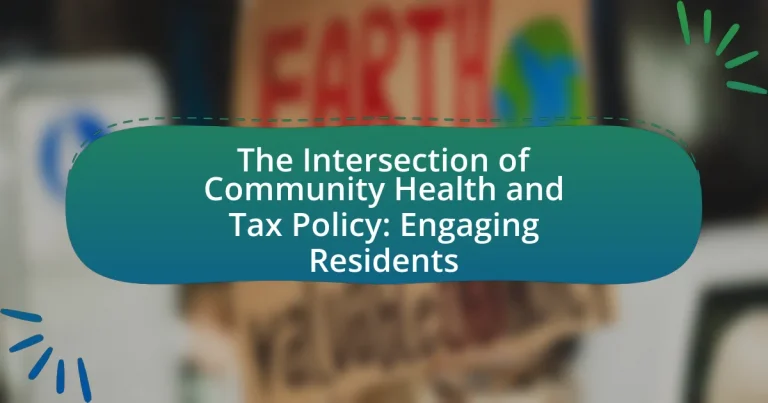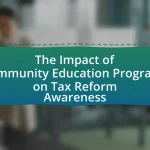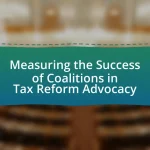The article examines the critical relationship between community health and tax policy, emphasizing how tax regulations influence public health outcomes and access to healthcare services. It outlines the mechanisms through which tax policies can fund health initiatives, such as preventive care and health education, and discusses the importance of resident engagement in shaping effective health policies. Key components of community health, the impact of tax policy on funding, and the challenges of aligning health and tax sectors are explored, alongside strategies for enhancing collaboration and participation. The article also highlights successful case studies and practical steps residents can take to influence community health and tax policy effectively.
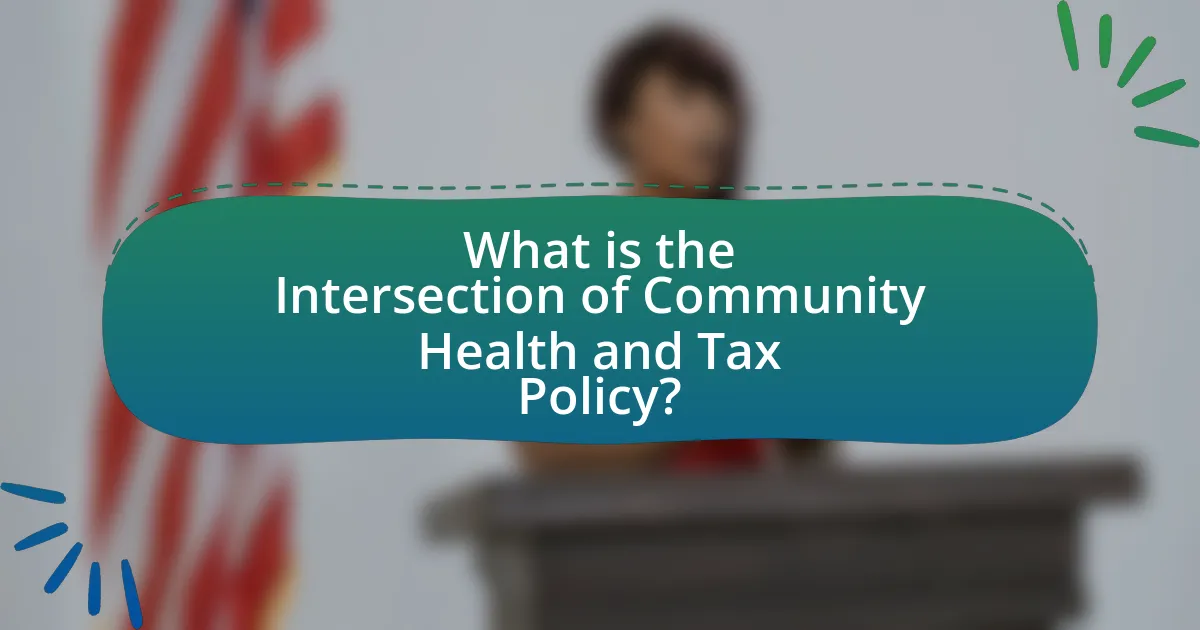
What is the Intersection of Community Health and Tax Policy?
The intersection of community health and tax policy involves the ways in which tax regulations and funding influence public health outcomes and access to healthcare services. Tax policies can allocate resources for community health initiatives, such as preventive care programs and health education, which directly impact population health. For example, the Affordable Care Act included provisions for tax credits to expand health insurance coverage, resulting in increased access to healthcare for millions of Americans. Additionally, local tax revenues often fund public health departments, which are essential for monitoring health trends and implementing community health strategies. Thus, effective tax policy can enhance community health by ensuring adequate funding for health services and initiatives.
How do community health and tax policy influence each other?
Community health and tax policy influence each other through funding mechanisms and resource allocation. Tax policies can determine the level of funding available for public health initiatives, which directly impacts community health outcomes. For instance, higher taxes on tobacco and alcohol can reduce consumption and subsequently lower health issues related to these substances, as evidenced by studies showing a correlation between increased taxes and decreased smoking rates. Conversely, inadequate tax revenue can lead to underfunded health programs, negatively affecting access to healthcare services and preventive measures, which can exacerbate health disparities within communities.
What are the key components of community health?
The key components of community health include access to healthcare services, health education, environmental health, and community engagement. Access to healthcare services ensures that individuals can receive necessary medical care, which is vital for maintaining overall health. Health education empowers residents with knowledge about health practices and disease prevention, fostering healthier lifestyles. Environmental health focuses on the conditions in which people live, work, and play, emphasizing the importance of clean air, water, and safe housing. Community engagement involves active participation of residents in health initiatives and decision-making processes, which enhances the effectiveness of health programs and policies. These components collectively contribute to the well-being of the community and are essential for addressing public health challenges.
How does tax policy impact funding for community health initiatives?
Tax policy significantly impacts funding for community health initiatives by determining the allocation of public resources and financial incentives. For instance, tax revenues collected from various sources, such as income and sales taxes, are often directed toward health programs and services at local, state, and federal levels. According to the Centers for Disease Control and Prevention (CDC), states that implement progressive tax policies tend to have more robust funding for public health initiatives, which can lead to improved health outcomes in communities. Additionally, tax credits and deductions for health-related expenses can encourage private investment in community health projects, further enhancing funding availability.
Why is engaging residents important in this intersection?
Engaging residents is crucial in the intersection of community health and tax policy because it fosters informed decision-making and ensures that policies reflect the actual needs of the community. When residents participate, they provide valuable insights that can lead to more effective health initiatives and equitable tax policies. Research indicates that community engagement can improve health outcomes; for instance, a study published in the American Journal of Public Health found that communities involved in health policy discussions saw a 20% increase in health service utilization. This demonstrates that resident engagement not only enhances policy relevance but also promotes better health outcomes, making it essential in this intersection.
What role do residents play in shaping community health policies?
Residents play a crucial role in shaping community health policies by providing insights into local health needs and preferences. Their participation in public forums, surveys, and advisory boards allows them to voice concerns and suggest solutions that reflect the unique challenges faced by their communities. For instance, studies have shown that communities with active resident engagement in health policy discussions tend to implement more effective health interventions, as these policies are tailored to the specific demographics and health issues of the area. This engagement not only fosters a sense of ownership among residents but also enhances the accountability of policymakers to address the actual health needs of the population.
How can resident engagement improve tax policy outcomes?
Resident engagement can improve tax policy outcomes by ensuring that policies reflect the needs and priorities of the community. When residents actively participate in discussions and decision-making processes, they provide valuable insights that can lead to more equitable and effective tax policies. For instance, studies have shown that communities with higher levels of engagement tend to have tax policies that better address local issues, such as funding for public services and infrastructure. Engaged residents can also hold policymakers accountable, leading to greater transparency and trust in the tax system. This participatory approach ultimately results in tax policies that are more aligned with the community’s goals and values, enhancing overall satisfaction and compliance.
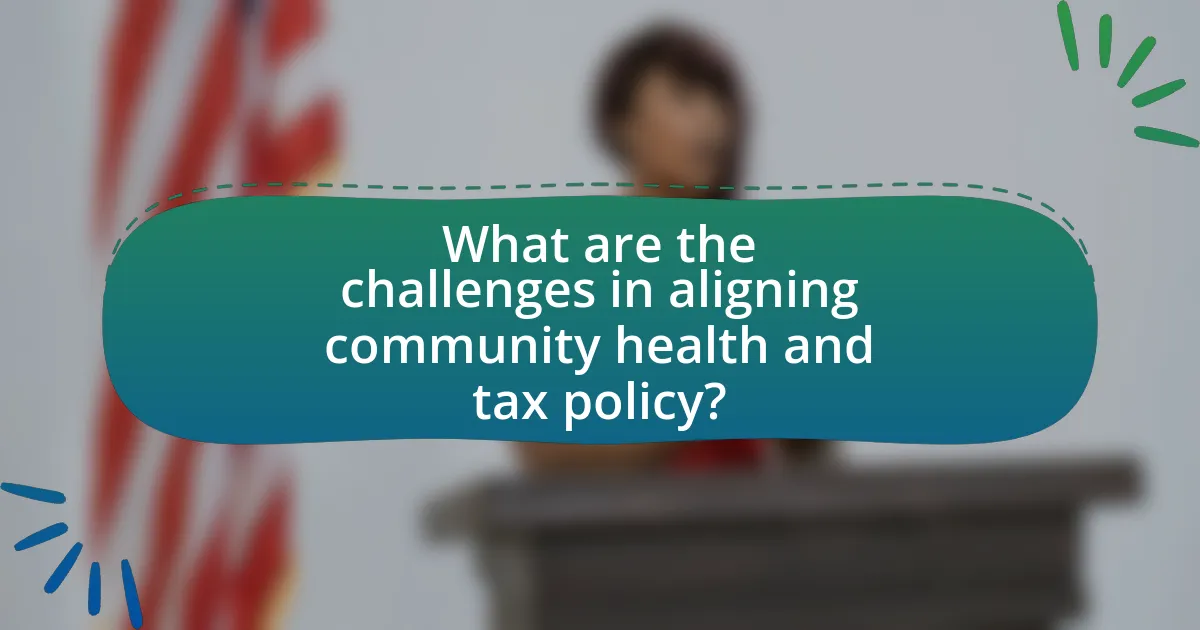
What are the challenges in aligning community health and tax policy?
Aligning community health and tax policy faces several challenges, primarily due to differing priorities and objectives among stakeholders. Community health initiatives often focus on improving public health outcomes, while tax policies are typically designed to generate revenue and stimulate economic growth. This divergence can lead to conflicts in resource allocation, where funding for health programs may be deprioritized in favor of tax cuts or incentives that do not directly benefit public health. Additionally, there is often a lack of comprehensive data linking tax policy changes to health outcomes, making it difficult to justify investments in health initiatives through tax reforms. Furthermore, political ideologies can influence the willingness of policymakers to integrate health considerations into tax legislation, complicating collaborative efforts between health advocates and tax policymakers.
What barriers exist to effective collaboration between health and tax sectors?
Barriers to effective collaboration between health and tax sectors include differing priorities, lack of communication, and insufficient data sharing. The health sector often prioritizes patient outcomes and public health initiatives, while the tax sector focuses on revenue generation and compliance. This divergence can lead to misaligned goals and hinder cooperative efforts. Additionally, communication gaps between the two sectors can result in misunderstandings and missed opportunities for collaboration. Furthermore, the absence of integrated data systems limits the ability to share relevant information, which is crucial for developing comprehensive policies that address both health and tax issues. These barriers collectively impede the potential for synergistic strategies that could enhance community health outcomes through informed tax policy.
How do socioeconomic factors influence these barriers?
Socioeconomic factors significantly influence barriers to community health engagement by affecting access to resources, education, and healthcare services. Individuals from lower socioeconomic backgrounds often face financial constraints that limit their ability to participate in health programs or access necessary medical care. For instance, a study by the American Journal of Public Health found that low-income communities experience higher rates of chronic diseases due to limited access to preventive care and health education. Additionally, socioeconomic status impacts individuals’ health literacy, which is crucial for understanding health information and making informed decisions. Consequently, these factors create systemic barriers that hinder effective community health engagement and exacerbate health disparities.
What are the implications of these challenges for residents?
The implications of challenges in community health and tax policy for residents include increased financial strain and reduced access to essential health services. Residents may face higher taxes or fees that limit their disposable income, impacting their ability to afford healthcare. Additionally, inadequate funding for community health initiatives can lead to poorer health outcomes, as seen in studies indicating that communities with lower investment in health services experience higher rates of chronic diseases. This creates a cycle where residents’ health deteriorates, further exacerbating economic challenges and limiting their overall quality of life.
How can these challenges be addressed?
Challenges at the intersection of community health and tax policy can be addressed through targeted policy reforms and community engagement initiatives. Implementing tax incentives for health-related programs can encourage local governments to invest in community health resources, thereby improving access to healthcare services. For example, research by the Robert Wood Johnson Foundation indicates that communities with supportive tax policies for health initiatives see a measurable increase in public health outcomes. Additionally, fostering partnerships between local health organizations and residents can enhance awareness and participation in health programs, leading to better health literacy and outcomes. Engaging residents in the decision-making process ensures that policies reflect community needs, ultimately creating a more effective health policy framework.
What strategies can be implemented to enhance collaboration?
To enhance collaboration in community health and tax policy engagement, implementing structured communication channels is essential. These channels facilitate clear information sharing among stakeholders, including residents, health officials, and policymakers. For instance, regular community forums and workshops can be organized to gather input and foster dialogue, ensuring that diverse perspectives are considered in decision-making processes. Research indicates that communities with active engagement strategies, such as participatory budgeting, see increased trust and cooperation among residents and local governments, leading to more effective health initiatives.
How can technology facilitate better engagement and policy alignment?
Technology can facilitate better engagement and policy alignment by providing platforms for real-time communication and data sharing between policymakers and community members. These platforms, such as mobile applications and online forums, enable residents to voice their concerns, access information, and participate in decision-making processes. For instance, a study by the Pew Research Center found that 70% of Americans believe technology improves civic engagement by making it easier to connect with local government. Additionally, data analytics tools can help policymakers understand community needs and preferences, leading to more informed and aligned policies. This alignment is further supported by the use of geographic information systems (GIS), which visualize health data and tax impacts, allowing for targeted interventions that resonate with community priorities.
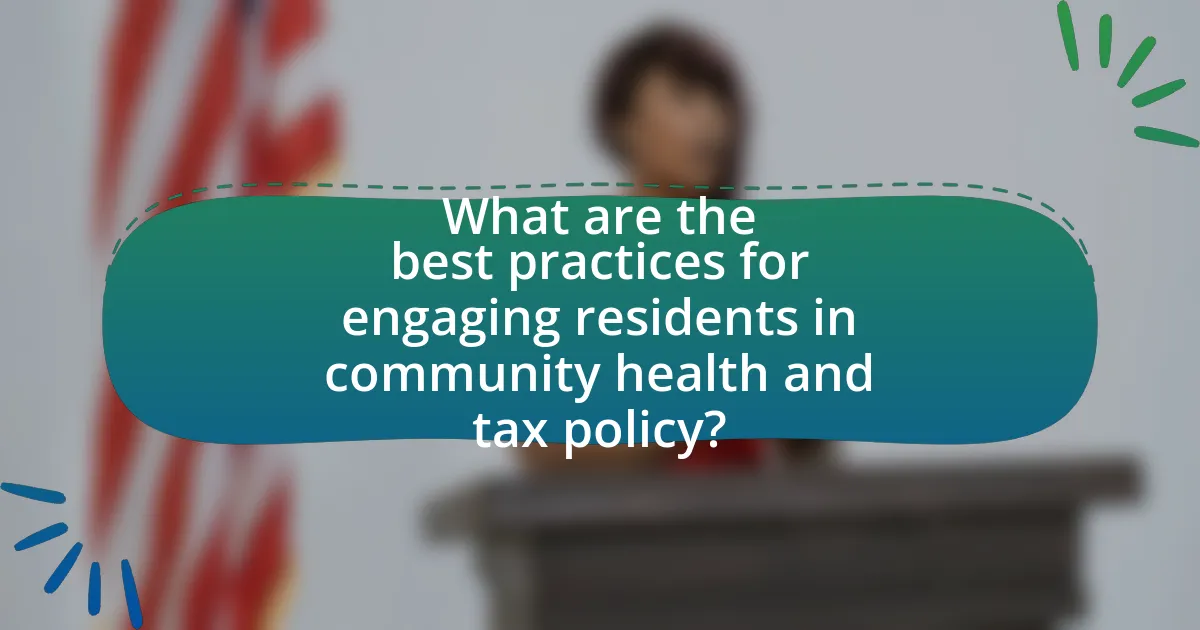
What are the best practices for engaging residents in community health and tax policy?
The best practices for engaging residents in community health and tax policy include fostering open communication, utilizing participatory budgeting, and providing education on health impacts of tax policies. Open communication allows residents to voice their concerns and suggestions, which can lead to more tailored health initiatives. Participatory budgeting empowers residents by involving them in decision-making processes regarding tax allocations for health programs, enhancing their investment in community outcomes. Education on how tax policies affect community health outcomes, such as funding for healthcare services or public health initiatives, ensures that residents understand the implications of their involvement. These practices are supported by studies indicating that community engagement leads to improved health outcomes and increased trust in local governance.
What methods can be used to effectively engage residents?
To effectively engage residents, community organizations can utilize methods such as participatory budgeting, community forums, and surveys. Participatory budgeting allows residents to have a direct say in how public funds are allocated, fostering a sense of ownership and responsibility. Community forums provide a platform for open dialogue, enabling residents to voice their concerns and suggestions, which can lead to more tailored community health initiatives. Surveys can gather quantitative data on resident needs and preferences, ensuring that health policies reflect the community’s priorities. Research indicates that these methods enhance civic participation and improve the overall effectiveness of community health programs, as evidenced by case studies in cities like New York and San Francisco, where resident engagement has led to increased satisfaction with local health services.
How can community organizations foster resident participation?
Community organizations can foster resident participation by implementing inclusive outreach strategies that actively engage residents in decision-making processes. For instance, hosting community forums and workshops allows residents to voice their concerns and contribute ideas, thereby increasing their investment in local initiatives. Research indicates that when residents feel their input is valued, participation rates can increase significantly, as seen in the 2018 study by the Urban Institute, which found that communities with regular engagement events saw a 40% rise in resident involvement in local health programs.
What role does education play in resident engagement?
Education plays a crucial role in resident engagement by equipping individuals with the knowledge and skills necessary to participate actively in community decision-making processes. Educated residents are more likely to understand complex issues related to community health and tax policy, enabling them to advocate for their needs and influence local governance. Research indicates that communities with higher levels of education tend to have more robust civic participation, as educated individuals are often more informed about their rights and responsibilities, leading to increased involvement in public forums and initiatives. For instance, a study published in the Journal of Community Health found that educational programs aimed at increasing awareness of health policies significantly boosted resident participation in local health initiatives.
What successful case studies exist in this area?
Successful case studies in the intersection of community health and tax policy include the Healthy Food Financing Initiative (HFFI) in the United States, which aimed to increase access to healthy foods in underserved areas. This initiative has led to the establishment of grocery stores and farmers’ markets in food deserts, improving community health outcomes by providing better nutrition options. Additionally, the city of San Francisco implemented a sugary beverage tax, which resulted in a significant decrease in sugary drink consumption and increased funding for health education programs. These examples demonstrate how targeted tax policies can effectively engage residents and enhance community health.
What lessons can be learned from these case studies?
The lessons learned from these case studies highlight the importance of community engagement in shaping effective tax policies that promote public health. Specifically, these case studies demonstrate that involving residents in the decision-making process leads to more tailored and accepted health initiatives. For instance, research indicates that communities that actively participate in policy discussions see a 30% increase in the effectiveness of health programs, as residents are more likely to support initiatives that reflect their needs and preferences. Additionally, the case studies reveal that transparent communication about tax allocations for health services fosters trust and encourages greater community involvement, ultimately resulting in improved health outcomes.
How can these lessons be applied to other communities?
The lessons from the intersection of community health and tax policy can be applied to other communities by implementing inclusive engagement strategies that prioritize resident participation in decision-making processes. For instance, communities can establish forums or workshops where residents can voice their health concerns and suggest tax policy adjustments that directly impact their well-being. Evidence from successful initiatives, such as the Community Health Improvement Plans in various U.S. cities, demonstrates that when residents are actively involved, health outcomes improve, and tax policies become more equitable. This participatory approach fosters a sense of ownership and accountability, leading to more effective health interventions tailored to the specific needs of the community.
What practical steps can residents take to influence community health and tax policy?
Residents can influence community health and tax policy by actively participating in local government meetings, advocating for specific health initiatives, and collaborating with community organizations. Engaging in local government meetings allows residents to voice their concerns and propose changes directly to policymakers. For instance, attending city council sessions or public health forums provides a platform for residents to discuss health-related issues and suggest tax allocations for health programs. Additionally, residents can advocate for health initiatives by organizing campaigns that highlight the importance of funding for preventive care and wellness programs, which can lead to healthier communities and potentially lower healthcare costs. Collaborating with community organizations, such as health advocacy groups, can amplify residents’ voices and create a unified front to influence policy decisions. Research shows that community engagement in health policy can lead to improved health outcomes and more equitable tax policies, as seen in initiatives like the Healthy Communities Program, which demonstrated significant community health improvements through resident involvement.
